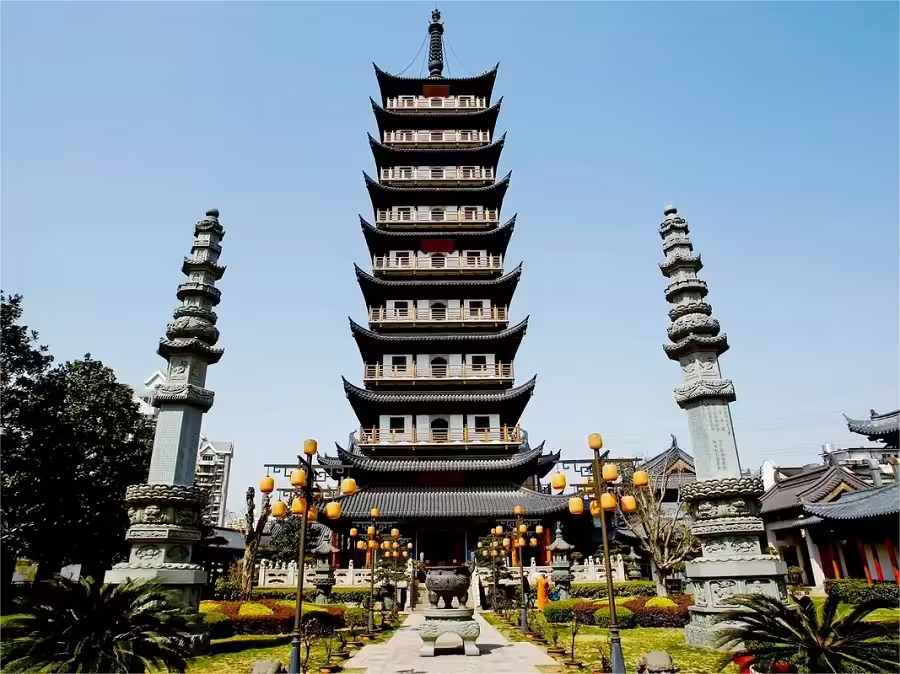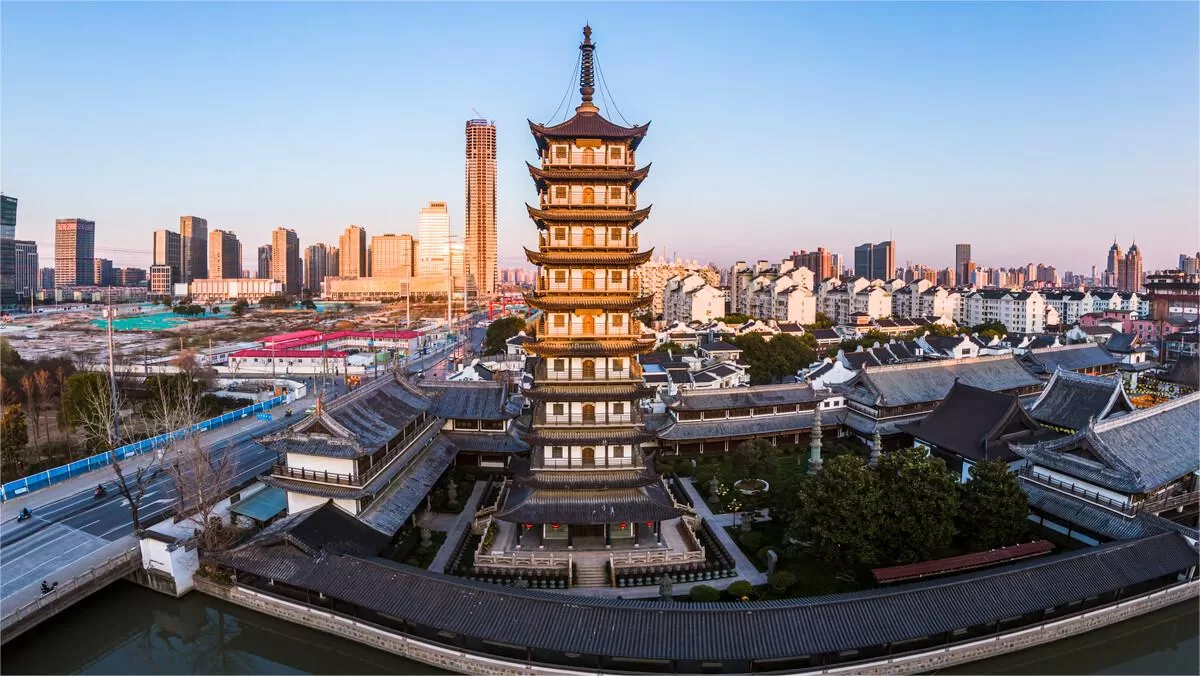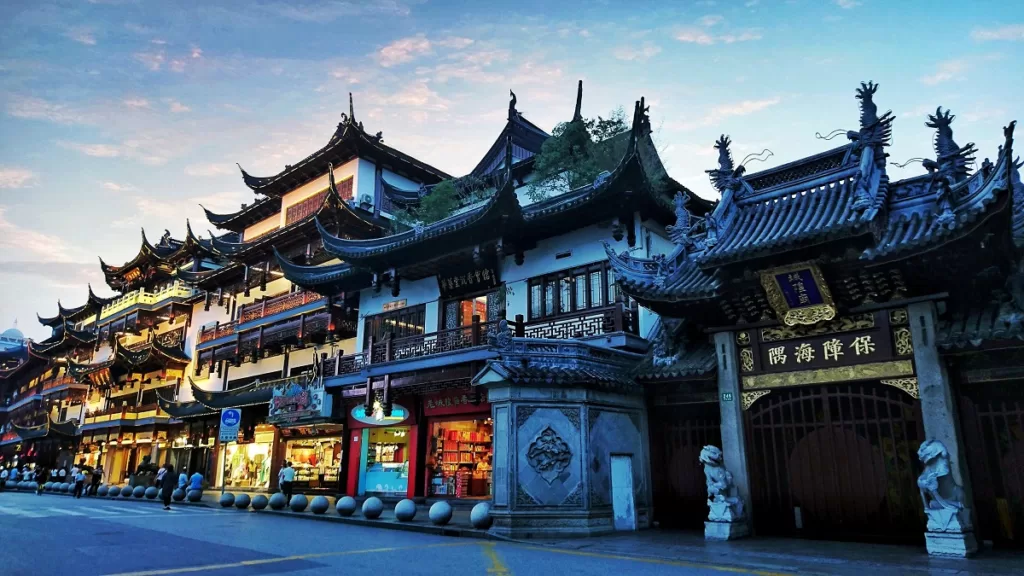Zhenru Temple (真如寺), located in the northwest corner of Shanghai in Zhenru Town, covers an area of nearly 20 acres and is an ancient temple dating back to the Song Dynasty, originally named “Wanshou Temple.” The temple, with its white walls and black tiles, exudes an ancient charm, and the fragrance of incense has been flourishing here for centuries. In comparison to other famous Shanghai temples like Longhua Temple, Zhenru Temple appears more tranquil, with a solemn Buddhist atmosphere that appeals to those seeking a peaceful and traditional place for prayer.
Although not large in size, Zhenru Temple features a well-organized layout. The prominent structure is a nine-story pagoda, modeled after the Song and Yuan dynasties, standing over 50 meters tall. Other notable buildings include archways, the main gate, incense burners, a bell and drum tower, Buddha halls, Bodhisattva halls, scripture halls, a library, and monk’s quarters. Stepping into the main hall, one can touch the beams and pillars dating back to the Yuan Dynasty, creating a sense of traveling back in time to a thousand years ago.
Table of Contents
- Basic Information
- Location and Transportation
- Highlights of Zhenru Temple
- Vlog about Zhenru Temple
- History of Zhenru Temple
- Useful Tips Summarized from Reviews
- Other Temples in Shanghai
Basic Information
| Estimated Length of Tour | 1 – 2 hours |
| Opening Hours | 6.00 -16.00; Last admission: 16.00 |
| Ticket Price | 10 RMB |
Location and Transportation
Zhenru Temple is situated in a peaceful and quiet area of the city, surrounded by trees and greenery. And its address is No. 399, Lanxi Road, Putuo District, Shanghai. To get there, you have the following options:
Bus: Take bus 724, get off at Tongchuanlu LanxiLu (铜川路兰溪路), and walk about 200 meters to the west to reach the temple.
Subway: Take subway line 11 or 14, get off at Zhenru Station (真如站), get out from Exit 7, and walk about 300 meters to reach the temple.
Highlights of Zhenru Temple
Yuantong Hall

Yuantong Hall features a central round lotus platform made of blue stone, standing 1.2 meters high. At the center of this lotus platform is a vajra, intricately decorated with deep relief carvings of the Heavenly Dragon and the Eightfold Division.
On the lotus platform is a 5.2-meter-tall, 3.5-ton statue of the Four-Faced Avalokiteshvara, crafted from white marble and brought from Singapore. The crown of the statue is adorned with sculptures of the Five Dhyani Buddhas, all carved from a single block of jade.
The hall’s ceiling is decorated with a chessboard-patterned sky lantern, featuring a thousand-armed and thousand-eyed Avalokiteshvara. This design symbolizes the deity’s ability to see all and protect all beings. Surrounding the lantern are wooden carvings of the Thirty-Two Transformations of Avalokiteshvara, creating an elegant canopy effect.
The hall’s walls are embellished with diverse stone-carved depictions of Avalokiteshvara’s twenty-eight attendants. Above these carvings is an inscription of the “观世音菩萨普门品 Universal Door of Avalokiteshvara Bodhisattva” by Zhao Puchu.
The Mahavira hall

The Mahavira Hall, covering an area of 165 square meters, is an exceptionally valuable example of Yuan Dynasty wooden architecture in Shanghai. The hall is square in shape, with three bays in both width and depth. Inside, the hall features 16 octagonal cypress columns: The Golden Pillar stands 6.45 meters tall with a diameter of 40 centimeters. And the Eaves Pillars are 4.28 meters high with a diameter of 32 centimeters.
The columns in the central bay are slightly inclined inward, with the Golden Pillar leaning in by 16 centimeters and the Eaves Pillar by 8 centimeters. This design is similar to the famous Yuan Dynasty architecture found in the Longhu Hall of the Yongle Palace in Shanxi Province.
The foundation is centered around the column bases, each independently supported. The area around the column bases, measuring 1.8 by 3 meters, has been filled with a deep layer of yellow earth and iron slag, compacted in layers to a depth of 1.8 to 2 meters. This construction method reflects the typical style of Song and Yuan Dynasty wooden structures.
Zhenru Pagoda

Completed in 1999, the Zhenru Pagoda is a significant structure standing 53 meters tall. It features a square base with nine outer layers and ten inner layers, totaling eleven levels including the basement. The pagoda’s south side is adorned with two large 4-meter-tall dharani steles.
The pagoda’s outer layers are inscribed with horizontal plaques. The south-facing gates on the first, sixth, and tenth levels carry inscriptions reading “众德悉俱 All Virtues Acquired,” “常得正念 Always Attaining Right Thought,” and “住深法性 Dwelling in Deep Dharma Nature,” respectively. The second-tier eaves feature a plaque with the calligraphy of Master Hongyi, inscribed with “真如佛塔 Zhenru Pagoda.”
The pagoda’s base level walls each display two 2×3-meter blue stone reliefs. Starting from the south gate and moving east, the reliefs depict: Namo Aiyida Bodhisattva, Namo Great Compassion Avalokiteshvara, Namo Great Vow Ksitigarbha, Namo Obstacle Removal Avalokiteshvara, Namo Great Action Samantabhadra, Namo Vajrapani, Namo Great Wisdom Manjushri, and Namo Akasagarbha Bodhisattva.
At the center of the pagoda’s underground chamber is a special room dedicated to a relic of Shakyamuni Buddha, making it the only Buddha’s relic in Shanghai.
Vlog about Zhenru Temple
History of Zhenru Temple
Zhenru Temple, originally known as the “Zhenru Courtyard,” has a storied history dating back to the Song Dynasty. It was first established during the Song Dynasty (960-1279) in the area of Guanchang, near modern-day Baoshan District’s Dachang. The temple was initially built by a monk named Yong’an, who renamed it Zhenru Courtyard in the Jia Ding era (1208-1224) to reflect the Buddhist concept of “true” and “constant” as described in the Cheng Weishi Lun (Treatise on the Doctrine of the Threefold Knowledge).
In 1320, during the Yuan Dynasty’s Yanyou era, the monk Miaoxin relocated the temple to its current location near Taopu and renamed it Zhenru Temple. A commemorative inscription from this period, still visible in the temple’s Great Hall, reads: “In the seventh year of Yanyou in the Yuan Dynasty, the year of the metal monkey, on the 20th day of the fifth month, during the hour of Xun, the temple was completed.” This marks the beginning of the temple’s present site.
Throughout its history, Zhenru Temple has undergone several reconstructions. During the Ming Dynasty’s Hongwu era (1368-1398), Hongzhi era (1488-1505), and Chongzhen era (1628-1644), the temple was rebuilt and renovated multiple times. Notably, in 1669 during the Qing Dynasty’s Kangxi reign, the eminent monk Benyuan from Huzhou was invited to preside over a grand ceremony at the temple, marking a significant moment in its history.
The temple suffered severe damage during the Taiping Rebellion in 1860 when British forces attacked and heavily damaged it. By the time of the late Qing Dynasty’s Guangxu era (1895), the temple was once again renovated thanks to a fundraising effort initiated by local rice merchant Yang from Zhenru Town, along with donations from monks Nian’an and Nianlun of Shanghai’s Shousheng Monastery. The renovation expanded the temple from its original single-eaved three-room structure to a five-room double-eaved design, while preserving the Yuan Dynasty architectural style.
In 1937, during the “August 13” Battle of Shanghai, the temple faced destruction again, with significant damage inflicted upon the Guanyin Hall, Kalan Hall, and Dizang Hall. By the founding of the People’s Republic of China in 1949, most of the temple’s structures were in ruins, with only the main hall and some statues remaining, including a well-preserved Tathagata statue amidst widespread damage to other figures and artifacts.
In 1950, while dismantling the front gate’s remnants, the original Yuan Dynasty structural components, such as the golden columns and brackets, were documented. The architectural expert Liu Dunzhen confirmed that many elements, including the wooden columns and the typical Yuan Dynasty construction techniques, were preserved. That year, funds were allocated for repairing the Buddhist statues, and protective measures were taken for the bronze Amitabha statue.
The temple faced further destruction during the commune period in 1958. However, between 1963 and 1964, the municipal government undertook a major restoration, replicating the Yuan Dynasty style. This restoration revealed additional details about the construction, including inscriptions on hidden components like beams and brackets, which significantly enhanced the historical value of the artifacts.
During the Cultural Revolution (1966-1976), Zhenru Temple experienced severe damage. The precious bronze Amitabha statue, a rare Ming Dynasty artifact from the Yongle era (1404), was sent to a scrap yard. The Tathagata statue and sandalwood frame were also destroyed, and the temple’s roof eaves, door plaques, stone lions, and inscriptions were vandalized.
After the Cultural Revolution, restoration efforts resumed. In 1978 and 1982, the city government allocated funds to repair the temple, which covers an area of over 850 square meters, including the main hall (173 square meters) and parts of the original Wang and Doshu Halls (about 120 square meters).
In August 1991, the Zhenru Temple Restoration Committee was established to oversee the restoration. The work was carried out in two phases: the first from 1992 to 1996, and the second from 1997 to 2006. In 1992, Singaporean monk Lin Gaosheng donated three jade Buddhas and scriptures to the temple. The temple was officially reopened to the public on February 4, 1992, marking the restoration’s completion and the revival of its religious activities.
Useful Tips Summarized from Reviews
Historic Interest: Zhenru Temple is an excellent destination for history enthusiasts due to its ancient architecture and cultural significance. However, even if you’re not deeply interested in history, it’s still worth a visit, especially if you’re in the area.
Bird Feeding: One unique feature of the temple is its large dovecote where visitors can feed the pigeons. You can purchase bird food from the vending machine for 10 RMB per bag, adding an enjoyable activity to your visit.
Ancient Ginkgo Tree: Don’t miss the 700-year-old ginkgo tree in front of the temple. Despite being struck by lightning in the past, it miraculously revived in 1992. Many visitors come to make wishes at the tree, adding to its mystique and charm.
Vegetarian Meals: If you’re interested in trying out Buddhist vegetarian cuisine, consider arriving around noon when the temple serves lunch. However, be aware that they may run out quickly, so it’s advisable to arrive early, preferably around 11:00 AM, to secure your meal.







I personally think that the flock of pigeons is also one of the highlights of Zhenru Temple, right? The pigeon house is located on the right side of the lawn in front of the Zhenru Pagoda. There are many pigeons in this area, and they are not afraid of people. If you have pigeon feed, just wave your hand and a flock of pigeons will gather above your head. It’s very picturesque, and there are self-service machines selling pigeon feed… Read more »